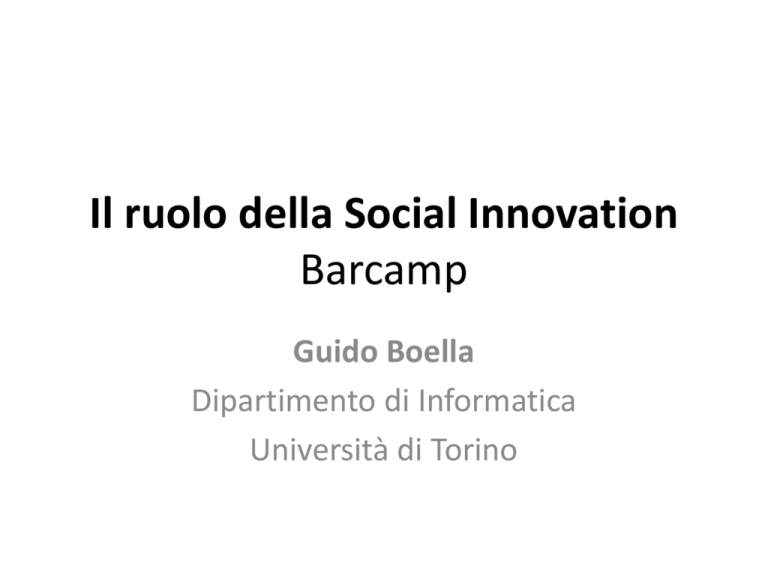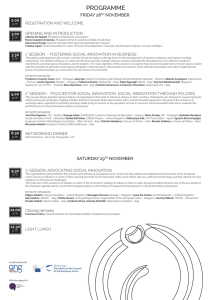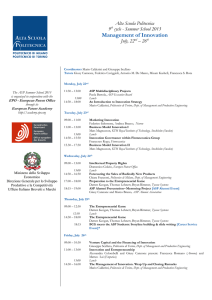Il ruolo della Social Innovation
advertisement

Il ruolo della Social Innovation Barcamp Guido Boella Dipartimento di Informatica Università di Torino Documento di partenza Empowering people, driving change: Social innovation in the European Union Bureau of European Policy Advisers (BEPA) EC Aprile 2010 Contesto • Tavola rotonda a Inaugurazione AA – Sergio Arzeni Organizzazione per la Cooperazione e lo Sviluppo Economico (OCSE) – Roberto Moriondo Regione Piemonte – Michelangelo Pistoletto Cittadellarte Fondazione Pistoletto – Mario Rasetti Fondazione Istituto per l'Interscambio Scientifico (I.S.I.) – Fabrizio Sestini Commissione Europea • HackUniTO #PROGETTARE E REALIZZARE SOLUZIONI, SERVIZI E DISPOSITIVI IN CROWDSOURCING, PER VIVERE IN MODO INNOVATIVO L'ESPERIENZA DI VITA E DI STUDIO NELL’UNIVERSITA’ E NEL TERRITORIO L'hackathon è un evento al quale partecipano esperti e studenti di diversi settori: sviluppo software, programmazione e grafica web, ma anche di temi connessi alla gestione dei servizi progettati e sviluppati (management, economia, fisica, chimica, ingeg neria, urbanistica, logistica, scienze umane, medicina, biotecnologia, comunicazione, marketing, gestione d’impresa,salute, diritto, ...) L'hackathon ha l'obiettivo di realizzare soluzioni, prodotti, servizi, applicazioni e piattaforme in aree di interesse per i partecipanti L'hackathon generalmente ha una durata variabile tra un giorno e una settimana #hackUniTO rappresenta il contesto operativo in cui si esprimono: • l’approccio del nuovo mandato rettorale in termini di innovazione, comunicazione ed engagement • l’attuazione di primi interventi concreti per portare a soluzione alcune delle criticità attuali • l’individuazione e la gestione di nuove opportunità per migliorare l’esperienza di vita e di studio all’interno del nostro Ateneo • le nuove modalità di relazione con il territorio e con le istituzioni • il piano di cooperazione con i centri di ricerca • il ruolo di attrazione di risorse e competenze che il nostro Ateneo deve assumere nel contesto nazionale ed internazionale • la nascita e lo sviluppo di Smart Communities all’interno dell’Ateneo e con altri Atenei • la collaborazione con le altre Università Il problema Social innovation relates to new responses to pressing social demands by means which affect the process of social interactions. It is aimed at improving well being. It covers wide fields which range from new models of childcare to web-based social networks, from the provision of domestic healthcare to new ways of encouraging people to exchange cars for bicycles in cities, and the development of global fair-trade chains. In its recent usage, the social innovation approach is understood to mean not only a new governance mode working across traditional fields of responsibilities with an active involvement of citizens, which is effective in addressing the challenges of climate mitigation, social justice, ageing, etc., but also the culture of trust and risk-taking which is needed to promote scientific and technological innovations. What is social innovation? Social innovations are innovations that are social in both their ends and their means. Specifically, we define social innovations as new ideas (products, services and models) that simultaneously meet social needs (more effectively than alternatives) and create new social relationships or collaborations. They are innovations that are not only good for society but also enhance society’s capacity to act. Precursori The academic literature on social innovation goes back to Max Weber who defined the relationship between the social order and innovation by the impact on social change of behaviours initially considered to be abnormal. Emile Durkheim also, in 1893, upheld that social regulation was important to consider for the development of the division of labour which went with technical change (social cohesion). Their understanding of social innovation was then referring to innovations in the organisation of work and of society. In 1932 Joseph Schumpeter created another theoretical landmark by establishing the fundamental role of innovation and structural change in the organisation of society and the role of the entrepreneur as a driver of development. in seguito • Social innovation re-emerged as a concept and practice in the 1990s as a way to cope with the consequences of economic restructuring, changes introduced by IT developments and mass unemployment. Perché ora? The long-held belief that economic growth creates employment and wealth that goes on to alleviate poverty has been disproved by recent events, and the time has now come to try new ways of bringing people out of poverty and promoting growth and well-being not only for, but also with citizens. Fattori Combined with globalisation, rapid technological change has wide-ranging impacts on society and profound implications on unemployment profiles. It increases the demand for skills, widening the gap between the skilled and unskilled. Increased migration into the EU poses pressing problems of inequality and social inclusion. The number of people who are inactive or unemployed is dramatically increasing. Too many people live in poverty and social isolation. An ageing and better-off population brings with it increased old age dependency and diseases of affluence (obesity, stress). The costs of climate change Non basta il mercato Operations of private markets often fail to meet social needs There are the problems of 1. external benefits — where the social benefits of an activity such as the provision of healthcare or education exceed the private benefits — 2. external costs — where the social costs of, for instance, polluting activities such as those generating greenhouse gases exceed the private costs. 3. information difficulties: patients find it difficult to assess the quality of doctors; parents are not always wellinformed about the educational performance of different schools; pension schemes are complex and difficult to understand. Oggi, broader meaning • ‘social innovations can be macro or micro, structural or local, they are introduced by an entrepreneurial spirit and through solidarity, either to improve the functioning of the organisation or to transform the organisation into a social enterprise, an enterprise with social objectives, an organisation pursuing social objectives or to empower it with a more participatory governance system’ (Nussbaumer and Moulaert 2007). Partecipativo • The process of social interactions between individuals undertaken to reach certain outcomes is participative, involves a number of actors and stakeholders who have a vested interest in solving a social problem, and empowers the beneficiaries. It is in itself an outcome as it produces social capital. Social needs are now more pressing • The global crisis has made it clear that most of the challenges we face today have taken on an increasingly social dimension. Among the most prominent are the fight against unemployment, ageing and climate change. Three broad categories 1) Grassroots social innovations that respond to pressing social demands not addressed by the market and are directed towards vulnerable groups in society. EG second-chance schools in France 2) A broader level that addresses societal challenges in which the boundary between ‘social’ and ‘economic’ blurs and which are directed towards society as a whole. The Red Cross or the Open University fall into this second category. 3) The systemic type that relates to fundamental changes in attitudes and values, strategies and policies, organisational structures and processes, delivery systems and services. Initiatives relating to actions to make citizens more aware of climate change and recycling are examples of this last category. These social innovations, which are often initiated by institutions, play a part in reshaping society as a more participative arena where people are empowered and learning is central. Risks of failures • Continental countries, with their heavier institutional traditions, have been less reactive, social innovation often being an add-on which fails to penetrate the system. • In Mediterranean countries, the persistence of strong systems of informal solidarity has also slowed down the process, and amongst the eastern Member • States, the weakness of having a civil society with no autonomous organisation or capacity has been a severe handicap. Risks of failures - the traditional risk-averse and cautious organisational cultures of administrations, - closed systems which favour single-issue solutions developed within clusters of organisations lacking mutual awareness, communication, networking and trust, - fragmented capacities (resources, infrastructures and intermediaries) and skills (training, design tools, monitoring, validation and evaluation) preventing the development of a rich ‘eco-system’ for enabling social innovations, and - insufficient stable, seamless and sustainable funding throughout all stages of the innovation cycle. Outputs: non solo GDP Decision-makers are becoming increasinglyaware that the growth of GDP does not give a comprehensive view of progress that can positively affect citizens’ life satisfaction. The level of wellbeing and social cohesion that ultimately provide the conditions of economic growth are also linked with the value of non-market goods and services, natural resources and other informal and unpaid activities which are not included inthe composition of GDP. Social innovation is precisely about the development of what are currently viewed as assets for sustainable development: environmental, human and social capital. Ostacoli • large bureaucracies, the inefficient use of staff with associated waste and • low productivity, the lack of incentives to innovate or improve service provision, • and the difficulties of providing a service that is flexible and responsive to the needs of users. • sustainability. Public finances come from taxation and public borrowing, and both of these sources are heavily constrained. • Here too, the current crisis has exacerbated these problems. The public sector deficit of several Member States is of such a magnitude that it almost certainly precludes any increases in spending of any kind Scientific challenge The field of social experimentation and innovation offers a source of material which has so far been insufficiently researched in comparison with its counterparts in business, science and technology. An error: although every aspect of life is connected, there are no reasons for believing that a single theory could explain phenomena as diverse as family life, urban communities, the evolution of workplaces, identity and conflict,crime and violence, exploitation and cooperation. The process of social interactions between individuals to reach certain outcomes • Or as Nobel Prize winner Joseph Stiglitz puts it, ‘we care not only about outcomes, but also about processes. It makes a difference, for instance, whether we choose what we consume or if it is given to us [...] an economic system is to be evaluated not just on outcomes but on how outcomes are arrived at.’ Il processo deve 1. Solutions must focus on the beneficiaries and be created with them, preferably by them, and never without them 2. Focusing on the strengths of individuals and communities rather than on their weaknesses 3. Capitalising on the diversity of ethnicities, ages, religions, gender, etc. and not just combating discrimination 4. Developing a holistic approach rather than fragmented responses to people’s diverse problems 5. Reinforcing and extending partnerships rather than having each organisation individually handling ‘its’ services and ‘its’ responsibilities 6. Collaborative working and networking as ways to stimulate social innovation Il processo deve 7. Creating outreach solutions based in the local community rather than global solutions, remote from people and communities 8. Investing more in cooperation than in competition 9. Mainstreaming and sustaining social innovation in order to optimise investment in new solutions and multiply their added value 10. Valuing not only certifiable skills but also new skills associated with the innovation and the discovery of what’s new, what has future and what works 11. Recognising and valuing social artists 12. Putting in place a new governance for learning Aziende In this sense, a recent Dutch study has revealed evidence from both SMEs and large firms showing that successful innovation is not just the result of technological inventions, but is also heavily reliant on ‘social innovation’. Social innovation is defined here as changing a firm’s organisation, management and labour in a way that is new to the organisation and/or the industry, with the effect of leveraging the firm’s technological knowledge base and improving organisational performance Rischi • A first risk to view social innovation as renaming or relabeling all those initiatives and practices that carry some social dimension. Rischi • A second concern, is about the respective roles of the private, public and third sectors. Of course, the private sector has an important role to play not just in the need for additional resources in a time of limited public budgets, but also for injecting the creativity, flexibility and innovativeness that characterise the business world. • However, such an involvement also raises issues of ethics, responsibility, quality of services, and access. In this sense, social innovation should not be seen as simply a way of privatising social services. It is intended to rather encourage an existing change of behaviour by people and institutions regarding the responsibility of finding the most appropriate solutions to respond to unmet social demands. This objective may be served by a flexible borderline between business innovation and social innovation that exploits their complementarities Rischi • A third risk is to confine social innovation to bottom-up or grassroots initiatives. • Social innovation is not necessarily about bottom-up initiatives that stem at the micro level from the activities of autonomous individuals and groups. Often, social innovation emerges at the local level from sharing and networking between a wide range of actors; it can also be generated by market initiatives with a social concern. However, as the European experience has shown over centuries of experimentation, social innovation can also stem from the macro/policy level, when policy-makers, public administrators, business and opinion leaders or academics reflect, propose and implement new ways to address social issues. Social platforms • A recent instrument developed in SSH is ‘social platforms’. A social platform aims to establish a European-wide dialogue between the scientific community, the policy-makers and the civil society organisations with a view to building a common research agenda with all the involved actors. Social platforms have already been created in the areas of ‘social cohesion and cities’, ‘families’ Systemic innovation While often successful in their own right, the overall impact of most of these innovations is limited as they usually remain small and locally focussed. Scaling up and successfully replicating innovations is, therefore, vitally important. However, even if scaled up, social enterprises and new products and services alone cannot effect the wide scale change that is so urgently needed. Profound innovation across entire systems is required. Systemic social innovation • Systemic social innovation involves the fundamental transformation of the systems of society on which we all depend – such as healthcare, housing, education or energy. • This is rarely achieved through a single organisation or sector, but involves a complex interaction of public policy and reforms to legislation, changes to business cultures and practices, as well as shifts in consumer attitudes and behaviour. Interconnessioni • “A set of interconnected innovations, where each is dependent on the other, with innovation both in the parts of the system and in the ways that they interact.” • This includes innovations such as cars: in order to transform the nature of transport, a whole raft of complementary innovations in terms of products and services (petrol stations, driving schools, road traffic management and so on) Non solo un innovatore Over the past twenty years there has been a paradigm shift in our understanding of how innovation actually takes place. This is referred to in the literature as a move from linear models of innovation to a systemic or networked model of innovation. New models of innovation depict a role for policy makers, less as innovators in their own right, and more as orchestrators or enablers of innovation. Componenti • Developing following a crisis or period of upheaval • New ideas, concepts and paradigms • New laws and/or regulations across a broad area • Coalitions for change of many actors and/or across more than one sector or scale • Changed market metrics or measurement tools • Changed power relationships and new types of power structures • Widespread diffusion of technology and technology development • New skills or roles across many actors • New institutions • Widespread changes in behaviour, structures and/or processes. Strumenti • Planning for systems change (for example, Curitiba’s famous transport system, Nantes’ experiment with parallel currency), which usually depend onthe backing of leaders with power and resources. • The design and creation of new towns, designed to embody and demonstrate a radically different model (such as Hammarby Sjöstad, Vauban and the other eco-towns). • Holistic pilots (like Robert Owen’s co-operatives in the 19th century, BRAC in Bangladesh or the Harlem Children’s Zone in the late 20th century) and whole system demonstrators (like the NHS’ recent attempt to show the effectiveness of combining many assistive technologies together). • Living Labs (which in some accounts are meant to develop and promote systemic innovation). • Networks (like NCSL’s Networked Learning Communities for school leaders) or the New York educational innovation zone) or the various collaboratives in health in the UK. Quali sono i fattori da mettere in campo per favorire una cultura dell’innovazione sociale che divenga sistema per il territorio. 1) 2) Comprensione di quali sono le sfide sociali emergenti nel territorio. Inserimento della problematica dell’innovazione sociale nella didattica degli Atenei, anche come guida per gli sviluppi tecnologici. 3) Il ruolo dell’interdisciplinarietà nella social innovation. 4) Organizzazione di momenti di formazione verso i cittadini. 5) Sviluppo di tool di collaborazione per creare comunità “socially engaged”. 6) Creazione di una pipeline di azioni per supportare la social innovation coinvolgendo diversi attori, dall’Università ai policy maker, dagli incubatori alle imprese. 7) Creazione di piattaforme di transizione dell’innovazione, creando un ambiente multi-stakeholders che includa business, policymakers, PA, accademia, no profit, etc. 8) Social innovation cluser e laboratori 9) Creazione di un ambiente favorevole in termini economici, fiscali e legislativi. 10) Promozione dei risultati dell’innovazione in altre regioni e a livello internazionale.

